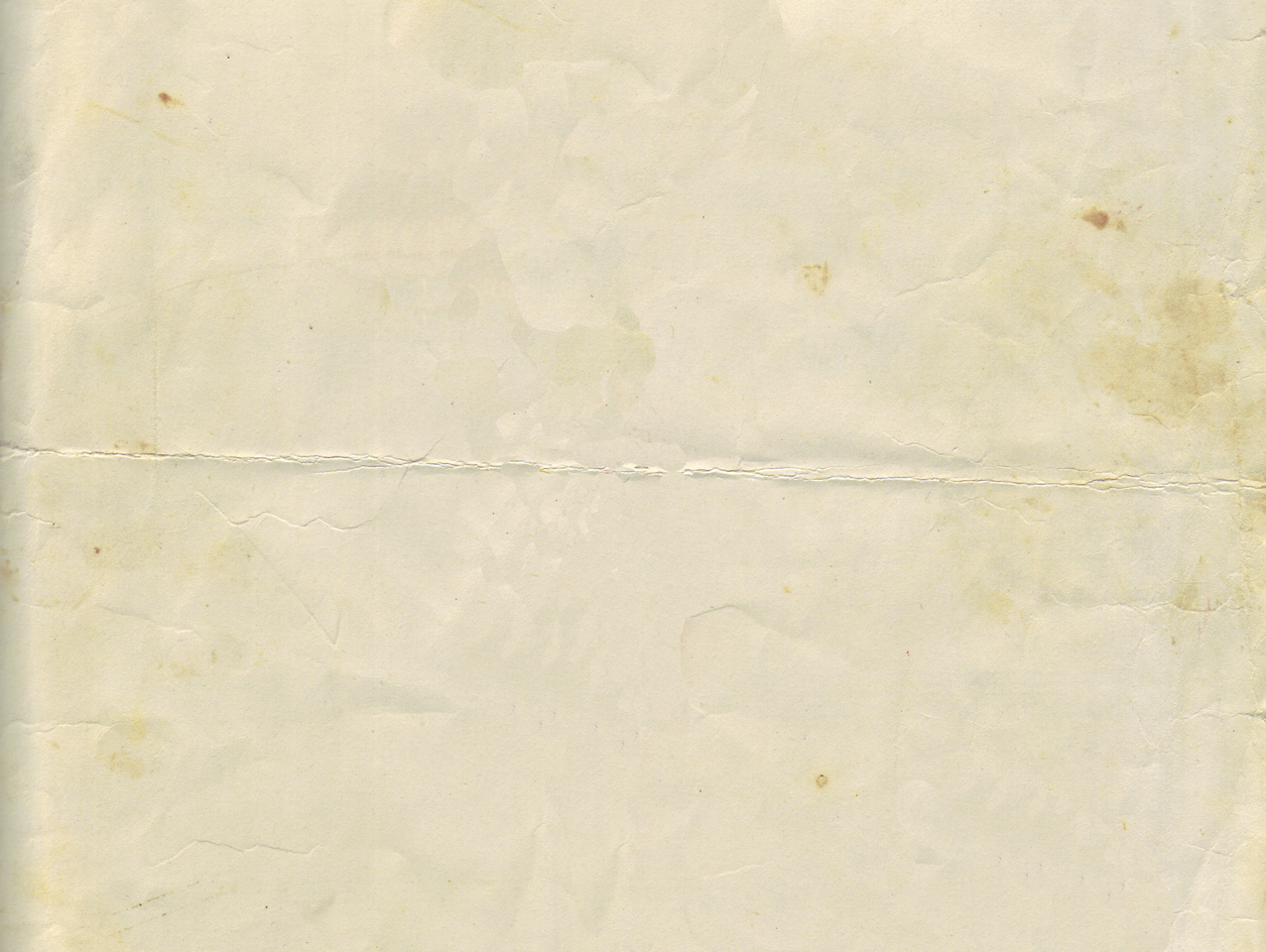Currently coloring my story for the Jason Rodriguez’s Colonial Comics anthology. Â This is page 2, panel 6. Â Still working on it.
Currently coloring my story for the Jason Rodriguez’s Colonial Comics anthology. Â This is page 2, panel 6. Â Still working on it.
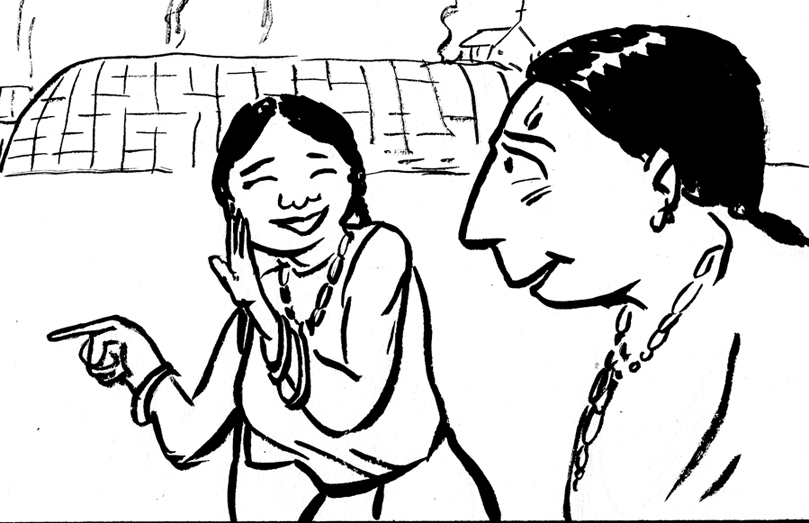 Page eleven of the story I’m working on for Fulcrum Press & Jason Rodriguez’s Colonial Comics anthology. Â Another scene at Kahnawake. Â THIS was all I had for a “script:”
Page eleven of the story I’m working on for Fulcrum Press & Jason Rodriguez’s Colonial Comics anthology. Â Another scene at Kahnawake. Â THIS was all I had for a “script:”
Eunice, about 15 years old, working in the fields, when she sees a handsome young warrior coming back from the hunt. Zing!
This would be the meeting between Eunice and her future husband. Â Eunice did marry a Mohawk man named Arosen, but how or when they met is pure speculation, so I speculated. Â I did some sketches in between caricatures at an event (ignore the silly childrens caricature border and that woman with the glasses):
Then the thumbnail (with bonus silly sketch and some numbers in the margin!):
As you can see, I decided to make this page / scene a bookend for the one on page 8. Two key moments in Eunice’s integration into the community/coming-of-age. I used an almost identical panel layout, with the large panels at top-left and lower-right demonstrating the “arc” of the page via Eunice’s change in attitude; and then the story being pushed along by a series of looks and glances in the smaller panels that take up the top-right and lower-left quarters of the page.
Also I had some problems with the way I drew Eunice in the first panel. Â She looked like she was tipping over. Â I just “straightened” her up with photoshop…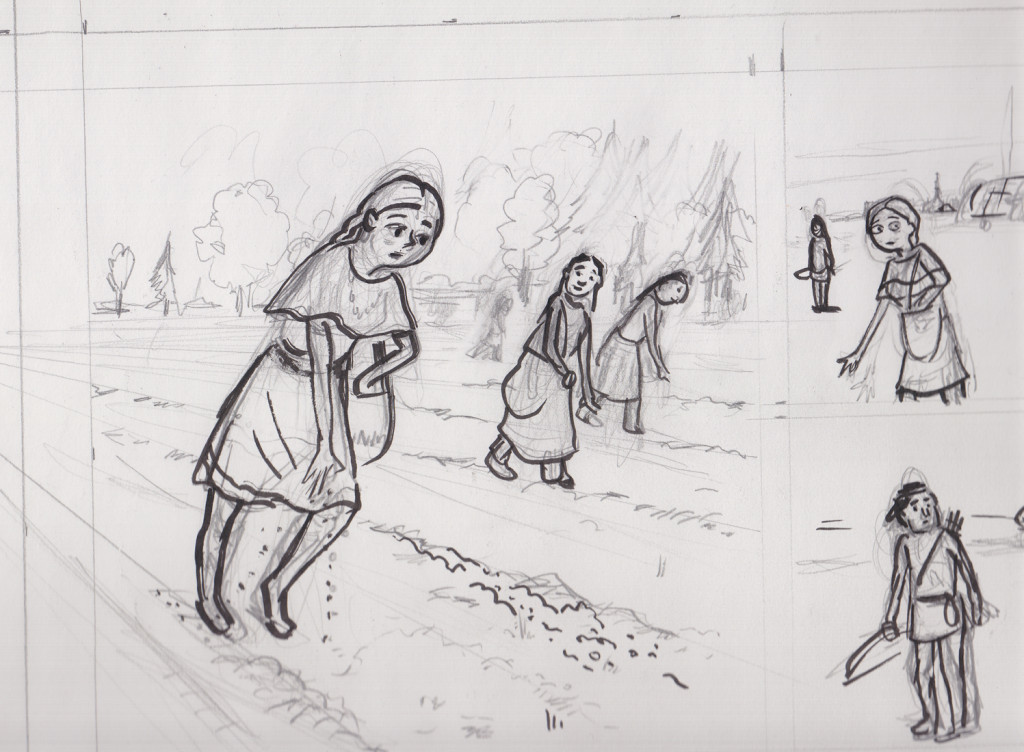
…see? Â (here’s the rough pencils/inks:) (with some of those sketches I did on the caricature sheet thrown in because I couldn’t do any better and why not?)
Oh, and I liked this little pencil sketch trying to get Eunice’s attitude in panel 4, so I just stuck it in the rough as well (before printing it out for light-boxing the final art).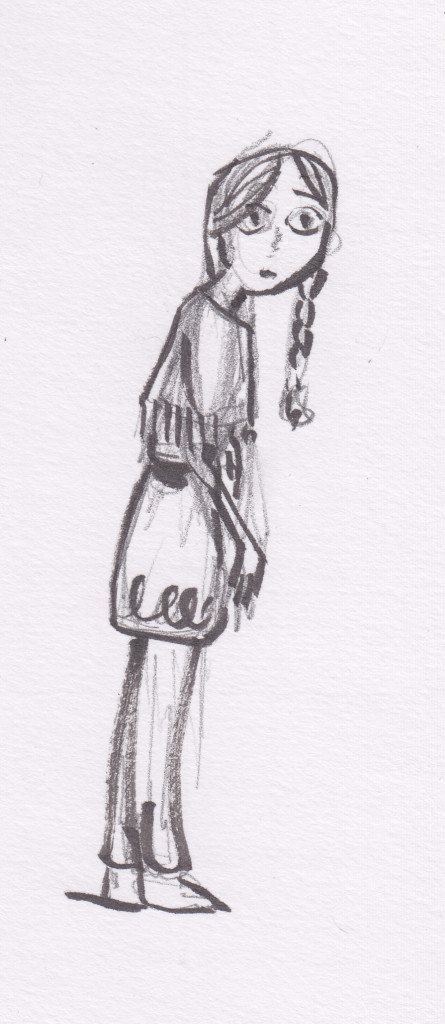
Final line-art:
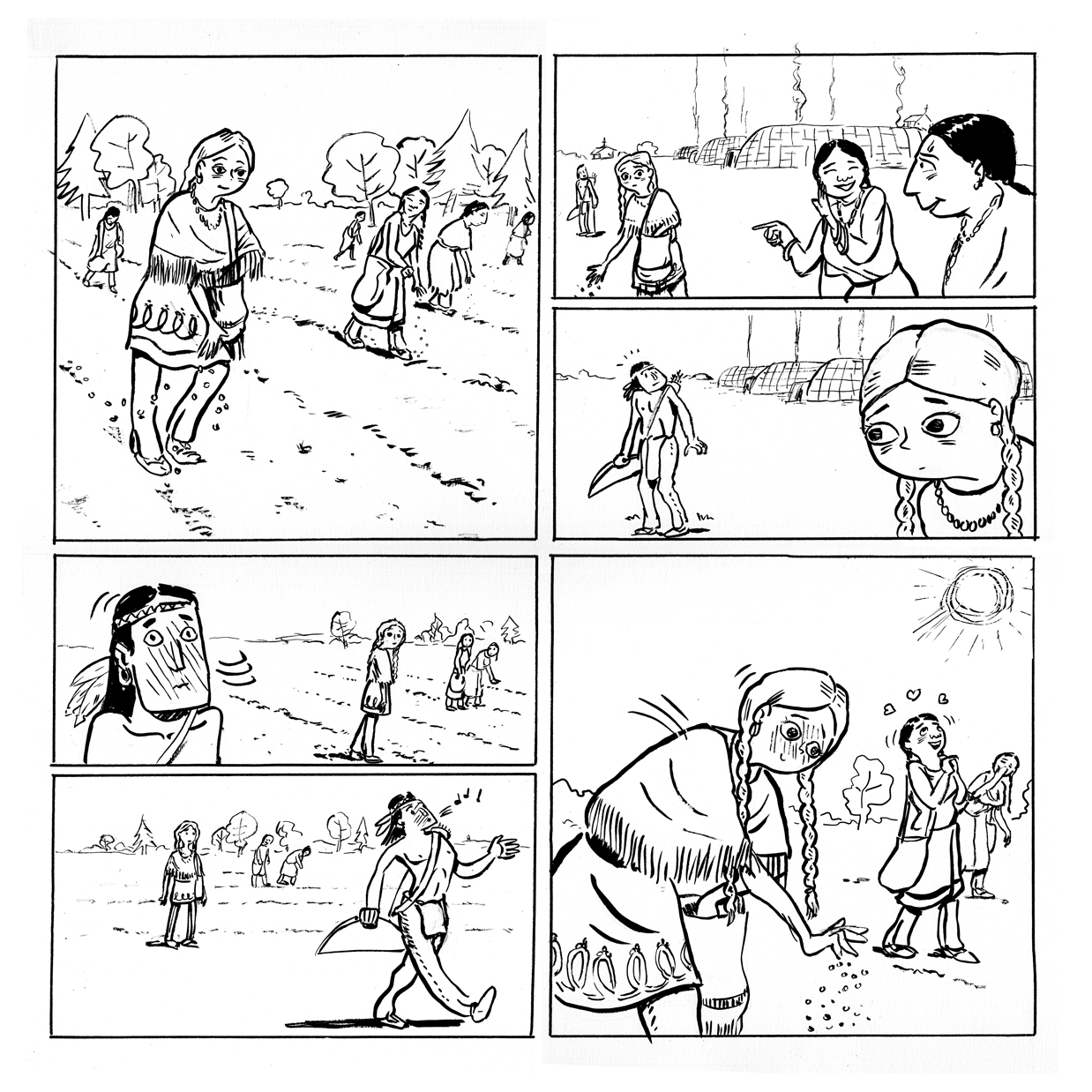 Final? Â Yeah, right! Â Seeing it now, I feel like Eunice’s head is too small in the last panel. Â I’m going to try and fix that digitally before I color it…
Final? Â Yeah, right! Â Seeing it now, I feel like Eunice’s head is too small in the last panel. Â I’m going to try and fix that digitally before I color it…
Page 10 of the project I’m working on for Jason Rodriguez’s Colonial Comics anthology from Fulcrum Press.
My outline-y script reads:
Eunice further assimilated into Kahnwake culture. Daily life centers very much around corn: planting, gathering, drying, grinding, cooking.
Being invited with the women to the fields is a big moment.
The home life in the longhouse is warm and communal.
So this is essentially a non-sequential page, but a series of vignettes that add up to Eunice’s generally happy childhood at Kahnawake. Â It’s a matter of putting the anecdotes into an overall page design or architecture that really can be read in any order. Â Since she left no written record of her time there, it’s all made up.
I definitely wanted to make use of the very first sketch I did for the story:
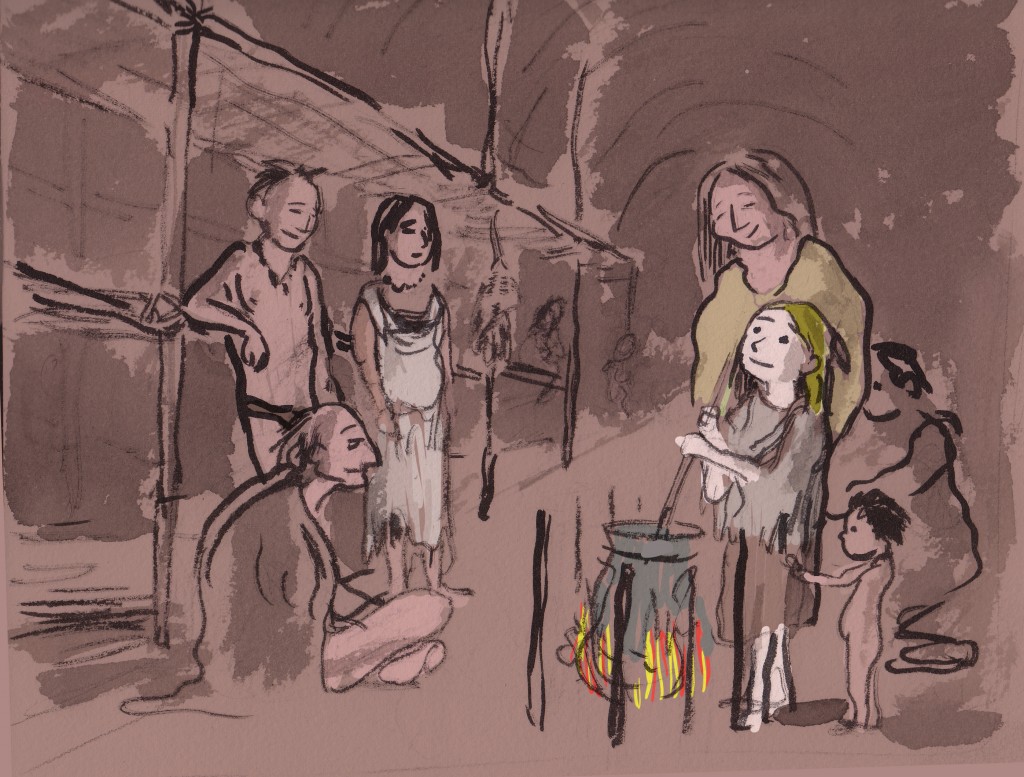
Then  lot of scribbling to figure how to arrange things:
The thumbnail:
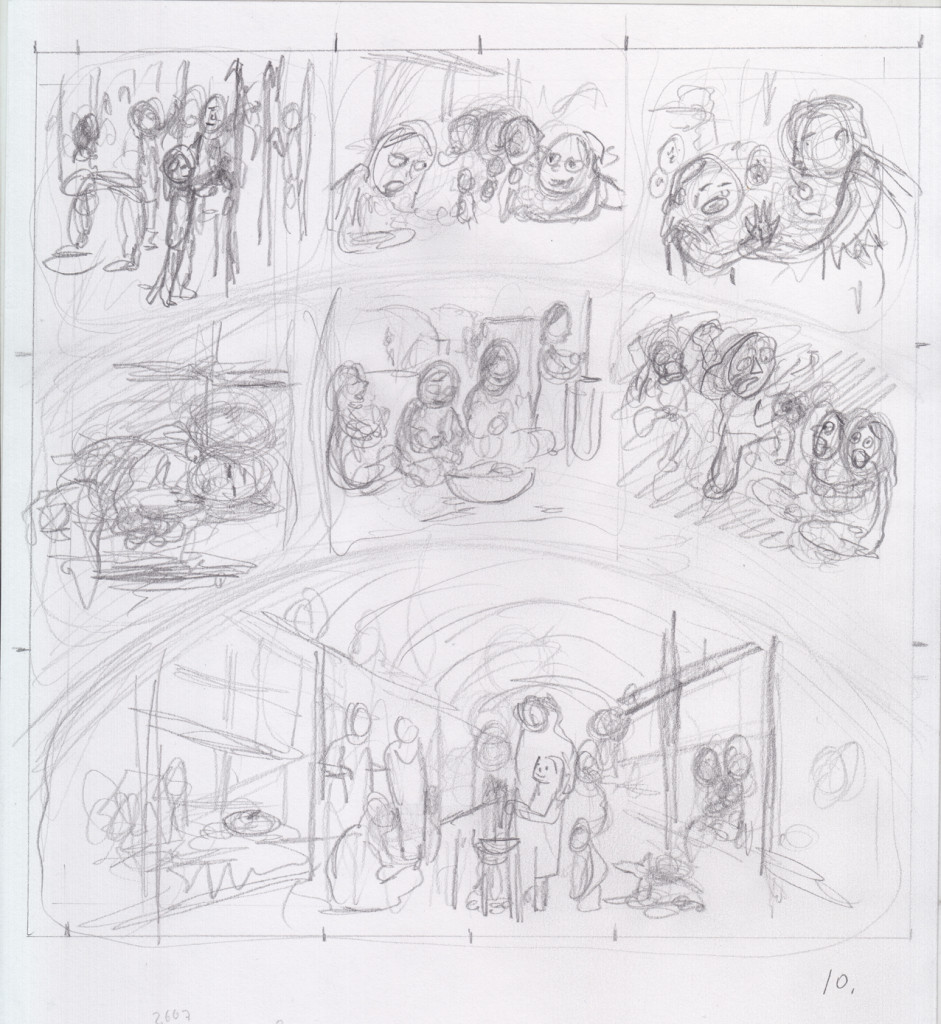
The rough. I decided to curve the drawings in that middle tier around the “archway” of the bottom panel, giving it more of an architectural feel:
The final line art, with blue pencils showing. Â No real reason to show this, I just like the way the blue pencil looks (the scan’s patched together, hence the different coloring):
And the final:
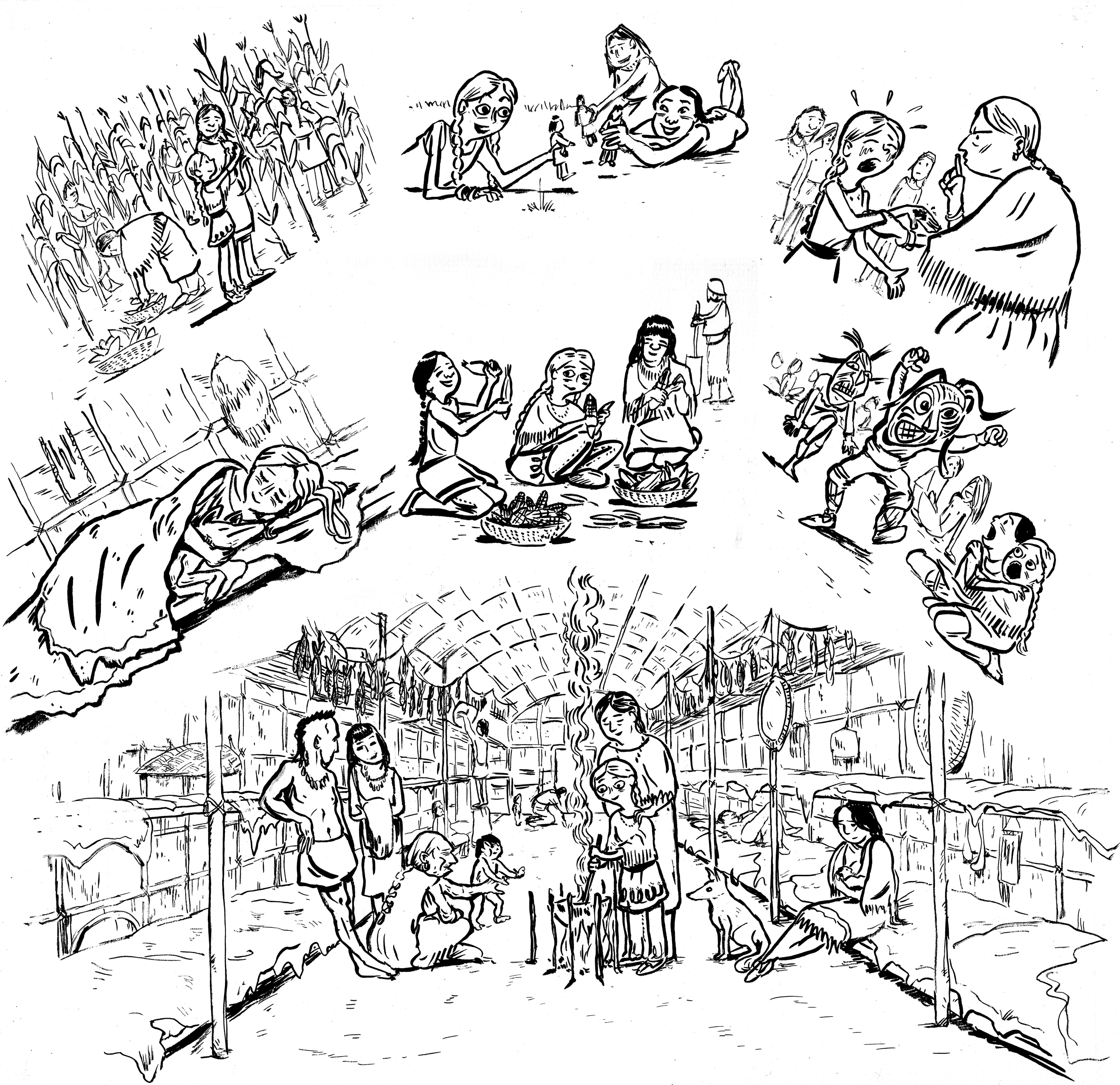
Going to be a challenge to color!
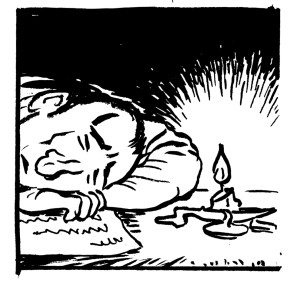 The next page for this story, about the aftermath of the Indian raid on Deerfield Mass. in 1704, which I’m working on for the Colonial Comics anthology from Fulcrum Press, was originally scripted like this:
The next page for this story, about the aftermath of the Indian raid on Deerfield Mass. in 1704, which I’m working on for the Colonial Comics anthology from Fulcrum Press, was originally scripted like this:
Â
PAGE 9Â
Page to be divided diagonally, maybe.
JOHN HALF: John returns to Boston. He becomes a celebrity, delivering sermons on his captivity. His book is a colonial best-seller. He continues his efforts to redeem Eunice.Â
EUNICE HALF Eunice further assimilated into Kahnwake culture. Daily life centers very much around corn: planting, gathering, drying, grinding, cooking.
Being invited with the women to the fields is a big moment.
The home life in the longhouse is warm and communal. Â
But if felt like too much story to pack into an 8×8 page — at least with the kind of storytelling I’m going for. Â This was going to be too dense a page to be easily read. Â I asked the editor if it was okay to make the story 2 pages longer (it has to stay an odd number for the book layout, and I could use an extra page at the end as well).
So, the story will now run 13 pages and here’s the thumbnal of the new page 9, Â just the “John” part of the old page 9:
Â
The rough:
 And final inks:
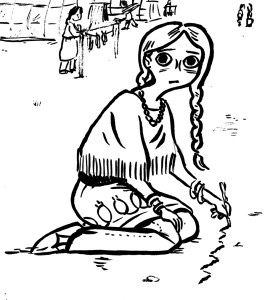
The next page in the story I’m drawing for Fulcrum Press‘ Colonial Comics anthology.
My “script” for the page:
PAGE 8
The Mohawk children have an easy life. Running around and playing. Eunice watches shyly as they play. They call her over. Then she is playing with them. Â
Thumbnail:
As you can see I added in the element of Eunice’s Indian mother intervening on her behalf with the other kids.
 I also realized that the transition from the narrated/dialogue pages (John’s story) to the wordless pages (Eunice’s story), needed to be smoothed out with a line of narration.  Otherwise it seemed too abrupt.  The rough pencils:
The square format lets you do some fun things that wouldn’t be possible in a conventional rectangular page. Here I tried to play with the two diagonal axes of a page divided into four equal quarters. Â So there’s the parallel/contrast between the lonely girl in the first panel and the playing children in the last, in the axis running top left-bottom right between two square panels. Â And then the opposite, axis – top right to bottom left – Â in which we “ride” a rough diagonal through the series looks from one character to the others:
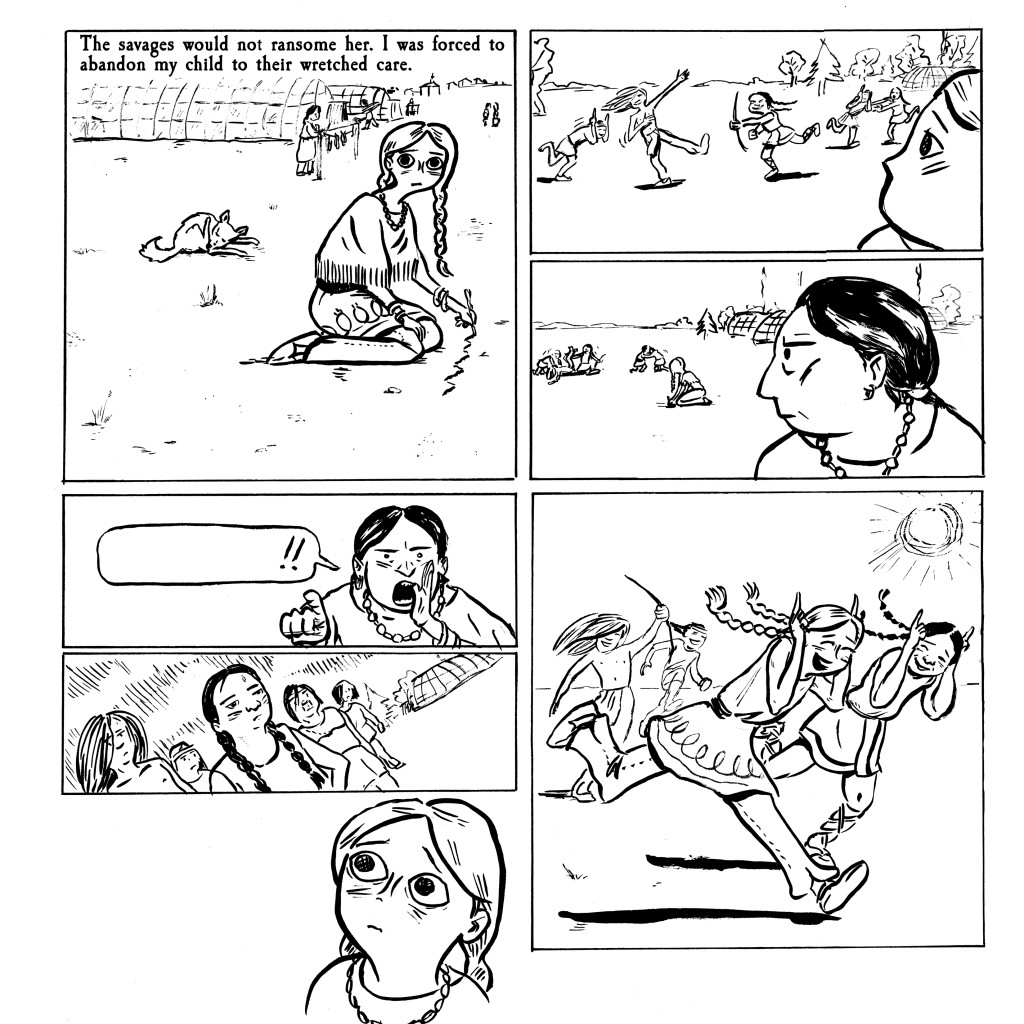
Continuing the process of drawing a short comic about John and Eunice Williams and the Deerfield Raid of 1704, for Colonial Comics anthology from Fulcrum Press…
Where the first 5 pages were primarily visual, these two switch to a dialogue mode. Â The majority of the dialogue is taken from John Williams’ text, some of it moved around from different parts of the book. Â For instance, the story John tells Eunice of the girl who’s forced to wear the cross, was actually a story told to John by his son (who was also captured) in a letter. Â I’m not sure if John had heard this story when he met with Eunice for the first time at Kahnwake, but I thought it presented his attitude toward children in captivity pretty well.
My script:
PAGE 6.
The Jesuits attempt to get John to convert (“by all means of flatteries and threats). Some of the following text to be used:
 I had many disputes with the priests who came thither; and when I used their own authors to confute some of their positions, my books, borrowed of them, were taken away from me, for they said, I made an ill use of them.
It was propounded to me, if I would stay among them, and be of their religion, I should have a great and honourable pension from the king every year. The superiour of the Jesuits said, “Sir, you have manifested much grief and sorrow for your separation from so many of your neighhours and children; if you will now comply with this offer and proposal, you may have all your children with you; and here will be enough for an honourable maintenance for you and them.†(and never expect to have them on any other terms)I told them, my children were dearer to me than all the world, but I would not deny Christ and his truths for the having of them with me.  What is a man profited if he gain the whole world, and lose his own soul?
 “After much supplication, Governour de Vaudreuil (of New France), arranged for me to see my youngest daughter.â€
 John is brought to Kahnawake see Eunice. Before he sees her, the Mohawk tell him that “they would as soon part with their hearts as my child.â€
 PAGE 7
The first meeting between John and Eunice, in the church at Kahnawake, with Jesuits present.
EUNICE: Father! Have you come to take me home?
JOHN: God has not willed that yet. Are you well?Â
She looks downcast.
EUNICE: Yes, father.
JOHN: Have you been mistreated?
JOHN: Do you remember to say your catechism?
EUNICE: Yes! But they make me say prayers in Latin, father! I don’t understand a word. Will it do me harm?
JOHN: Be strong: I have been told of an English girl bid to take and wear the cross, and cross her self: She refused; they threatened her: either to cross herself, or be whipt, she chose to be whipt; but seeing her choosing indeed to suffer rather than comply, they desisted.Â
Eunice doesn’t seem encouraged.Â
The layouts of these pages are fairly straightforward, my thumbnails were loose — extremely so in the case of page 7. Â I didn’t bother scanning the roughs, which I usually only do if I’m piecing them together from sketches and other attempts.
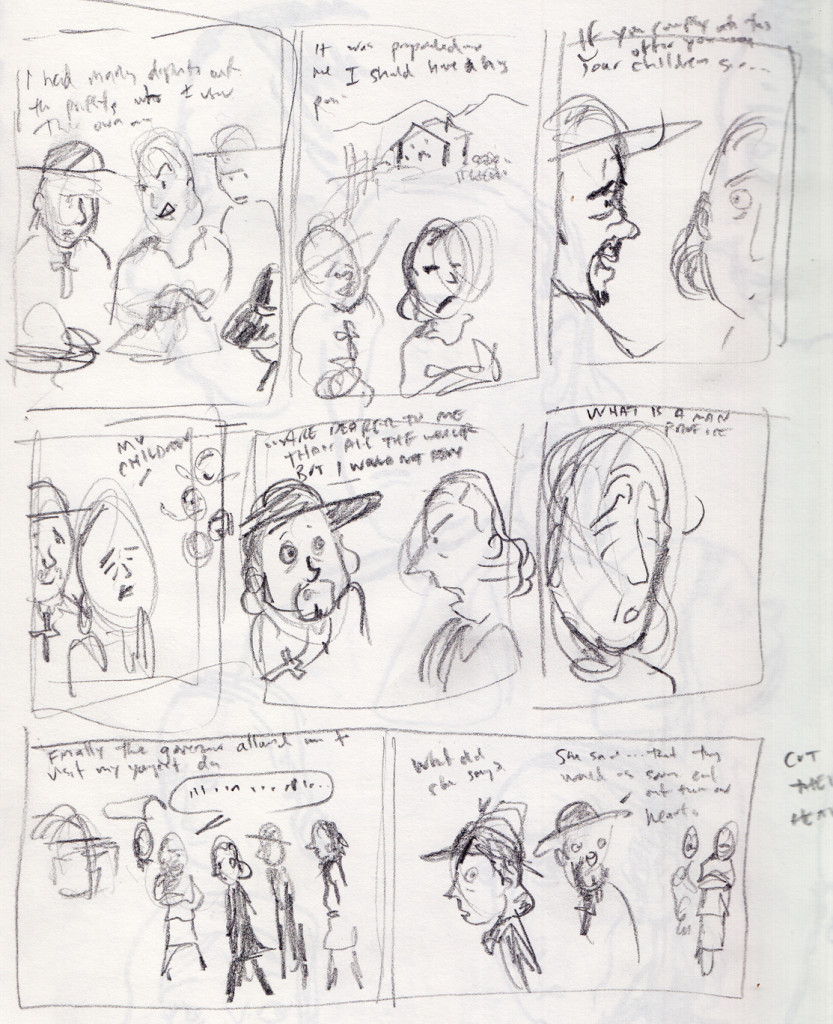
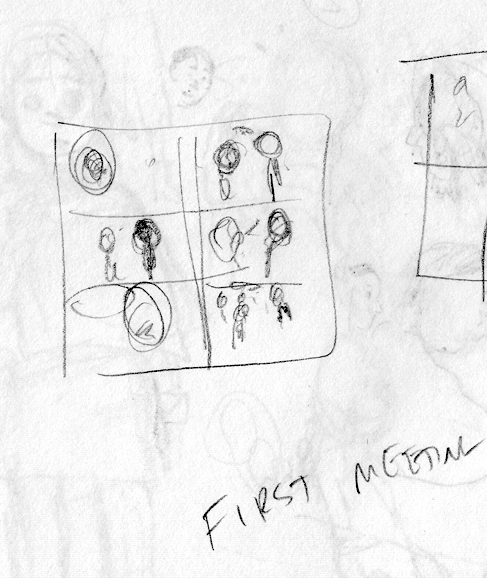
Drawing these two pages was much faster than the previous ones. My main focus was on the stylization/schematization of the characters. Â The style of drawing the two characters turns out to be different. John is more of a caricature style – almost Mort Drucker-ish at times , while Eunice is more of a Manga-influenced indie-comics look, that’s a little new for me; I’m really enjoying the simplicity and expressiveness this approach to her character allows. Even so, keeping the depiction of the characters consistent from page to page is proving a challenge.
The final line art:
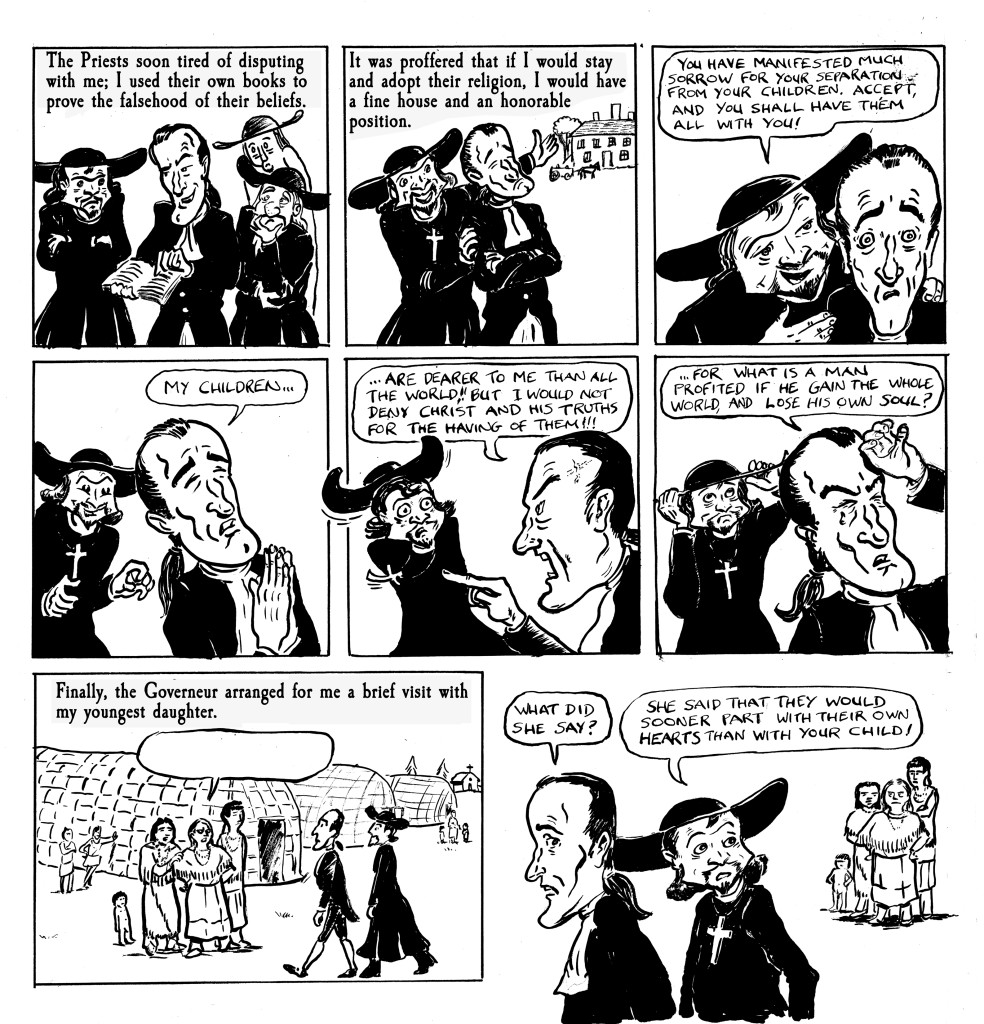
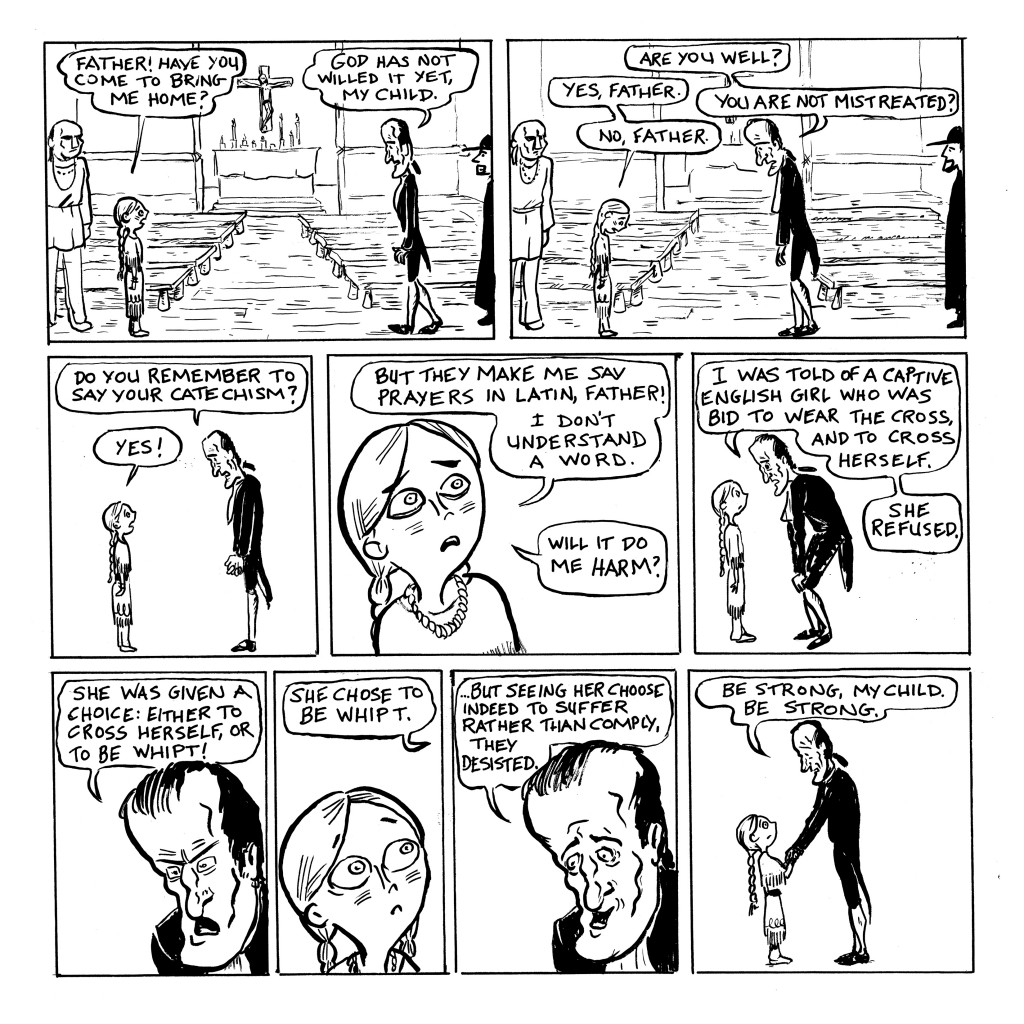
I don’t guess the following merits the word “script,” but this is what I was working from for this page:
PAGE 5
At Kahnawake, Eunice is welcomed warmly, embraced by her Indian “mother.â€Â Her rags are taken off and she is dressed in a new outfit, in the style of the Mohawk girls.
NOTES: Â The Iroquois nation at the time practiced the “Mourning War,” in which captives were taken for the purpose of replacing members of the tribe that had died, to ease the grief of their loved ones. Â “Captives could be adopted as a family member, literally taking the name and social position of the deceased” * Â It’s unknown whether Eunice was captured for this purpose, but possible, and I’m playing it that way.
The action of this page was also inspired by a passage in a book I read for research, “The Indian Captive,” by Lois Lenski, a fictionalized account (written for children in 1942) of a similar historical case.  The sensual appeal of the Indian clothes, faciliatate the  symbolic “changing of the skin” into that of an adopted culture.
I also thought  of the early shojo manga device of the “style picture.”  Shojo manga was aimed at young female readers, and the presentation of clothing and costume was an important element.  Often, an entire vertical section of the page was devoted to showing a character’s costume, in a panel that was often only loosely connected to the narrative flow of the comic, and using a decorative background rather than spatial continuity with the story:
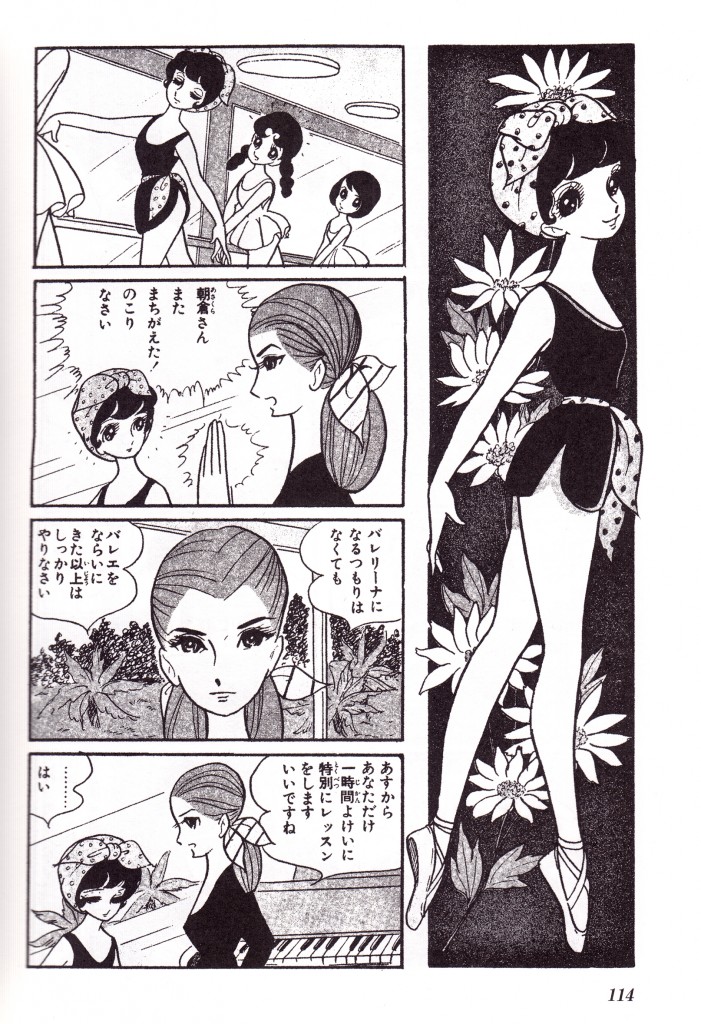
I wanted to get something of that feeling of that for this page.
The rough version:
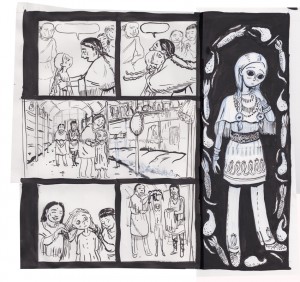
The final (so far):
Since Eunice obviously can’t understand the language of the Mohawks, I thought of getting the dialogue translated, so that readers couldn’t understand it either. Â I emailed the tribal council at Kahnawake to see about a translation, but haven’t heard back. Â In the meantime, I think the blank balloons might be a good solution!
The decorative pattern around Eunice in the “style picture” is based on the Iroquois “three sisters” of beans, corn and squash. Â My friend EJ Barnes, however, has since pointed out to me that, because I’m an idiot, I drew gourds instead of squashes (EJ didn’t call me an idiot, that’s my term). Â So that will have to be re-drawn.
*Evan Haefeli and Kevin Sweeney, Captors and Captives: The 1704 French and Indian Raid on Deerfield
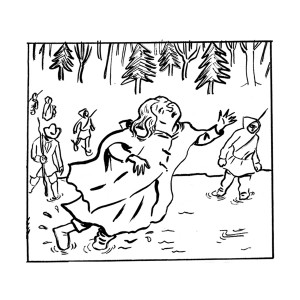 The third page of the story I’m working on for the Colonial Comics anthology from Fulcrum Books. Â The script for this page (notice a little bit of overlap with the last panel of page 2, I split one scene into two:)
The third page of the story I’m working on for the Colonial Comics anthology from Fulcrum Books. Â The script for this page (notice a little bit of overlap with the last panel of page 2, I split one scene into two:)
PAGE 3.
Long march begins, 80 captives and 250 Indians and French soldiers, through the snowy wilderness.
Behind them, smoke rises from the burning houses of Deerfield.
JOHN: “The journey being at least three hundred miles we were to travel …. the place we were to be carried to, a popish country.â€
Eunice (mother) can’t keep up with Eunice (daughter). Mother slips and falls into river as they cross. Mohawk warrior raises his tomahawk to kill her. Eunice (daughter) turns and sees, cries out. Another Mohawk man comforts her, picks her up and carries her on.
“My wife told me her strength of body began to fail, and that I must expect to part with her; saying, she hoped God would preserve my life, and the life of some, if not all of our chil dren, with us; and commended to me, underGod, the care of them.
“in passing through the river, she fell down, and was plunged over head and ears in the water; after which … the cruel and blood thirsty savage, who took her, slew her with his hatchet, at one strokeâ€
…Also those last couple passages are from John Williams’ book (full text available here, by the way). Â I put them in not neccesarily to use as text in the final comic, but just description to work from.
First a thumbnail:
Then I roughed out the page (assembled from sketches and pulled together on lightbox):
And finally (or so I thought):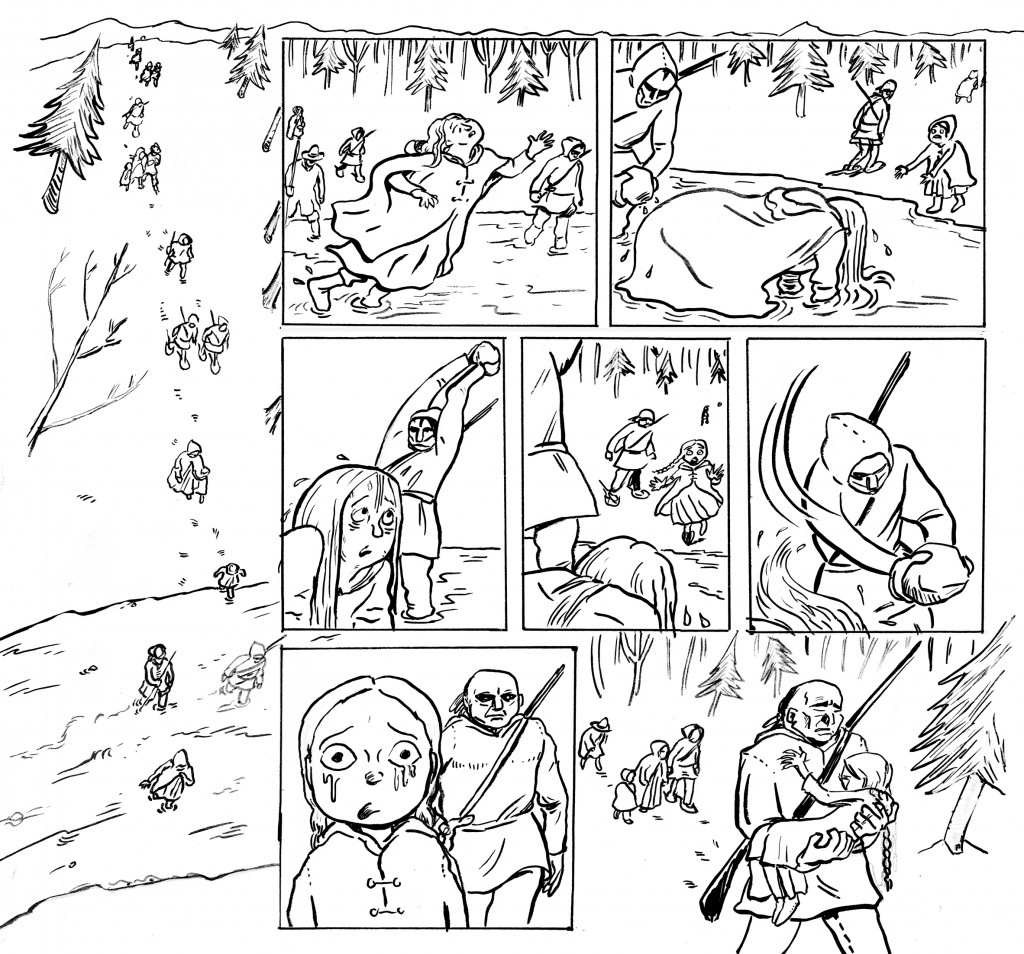
Pretty happy with this. Â I especially like the weird awkward falling figure in panel two, and the shape created by the prone figure in the next panel (which goes back to this teeny sketch weeks earlier:)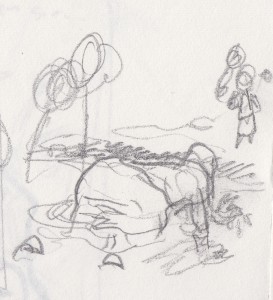
Buuuuuut… I took the finished page into the BCR meeting, and got some valuable feedback, especially from Shelli Paroline. Â First off, she recommended restoring the lettering in the first panel, which I’d thought to do without it. Â But I think that it will make the transition from one scene to the next smoother for the reader.
Secondly, there was some uncertainty as to the attitude of the Indian who picks Eunice up at the end. Â I also realized that, in this “cinematic” style of story-telling (cutting from different angles on the same action for the fall into the water, Eunice seeing her, the killing blow, the reaction), there was an unecessary “beat.” Â The middle panel in the middle tier, looking over the mother’s head as Eunice runs toward her: doesn’t really add any new information, and it does something weird to the pacing. Â So I could get rid of that panel, and add another beat to clarify the relationship between Eunice and the Indian man:
There now! Â Thank you lightbox for allowing me to preserve what I liked in the first version (I re-draw the whole page, I guess so there’s a nice original page as an end product). Â Though I’m not sure I don’t like the “striking” panel (panel 4 in this version) better in the one above.
Oh, and in case you’re interested, the finished work is drawn with brush and India ink (Dr. PH Martin’s Black Star) on bristol (Borden & Riley).
Thanks for looking!
My script for the page:
PAGE 2:
“I cannot relate the distressing care I had for my dear wife, who had lain-in but a few weeks before, and for my poor childrenâ€
Eunice (mother) clutches her children (including Eunice, daughter, 7), as Mohawk warriors menace them.
Warriors kill 2 children: a six-week old and four year old.
(“The enemies who entered the house… ….were so cruel and barbarous as to take … two of my children, and murder them.â€)
Long march begins, 80 captives and 250 Indians and French soldiers, through the snowy wilderness. Behind them, smoke rises from the burning houses of Deerfield.
JOHN: “Who can tell what sorrows pierced our souls, when we saw ourselves carried away from God’s sanctuary, to go into a strange land, exposed to so many trials ?
One challenge was drawing the panel where the invaders grab an infant from Eunice’s mother. Â At first I tried it as a full tableau:
Then I decided the action would be clearer and more dramatic closer up:
Another try:
But as I mentioned in a previous post, I’m pushing toward a more stylized treatment of the characters.  I think that will be more expressive, and more fun to draw. I’m particularly happy with how this worked in panels 1, 3 and 5. Here’s the rough version of the whole page:
As you can see, I condensed the killing of two Williams children into one — for space considerations, but also because the opening of this story is violent enough! Â The final version of the page (unless I change it more later):
T hanks for looking!
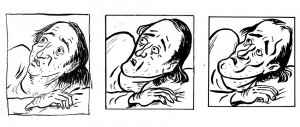
The format of the book is square (8″ by 8″) and I’m planning to tell this story in 11 pages. Â There will be an introductory page with some set-up information. Â Something like this:
” In 1701, war broke out between England and France. In the New World, the English colonies and New France (Canada) soon followed suit. Much of the fighting was done by Native American tribes allied with the two colonial powers. Settlements in the western frontier of New England were especially vulnerable to Indian raids; for the French, these raids served to terrorize and demoralize their British rivals, while for the Natives – Mohawk, Huron, Abenaki – a main goal was the taking of prisoners. Most of the captives were then ransomed back to the English for profit. Most, but not all…”
Except for the scenes in which they both appear, the comic will be divided into “Eunice†and “John†sequences, corresponding to full pages as often as possible. The John sequences will be narrated, wherever possible with excerpts from his actual writing. The Eunice sequences will have no narration, and not much dialogue.
My “script” is minimal, since I’m writing it for myself alone. Â Here is how I scripted page one (the text in quotes is from John Williams’ book, “The Redeemed Captive.”):
PAGE 1:
“ON the twenty-ninth of February, 1704, not long before the break of day, the enemy came in like a flood upon us.â€
Mohawk warriors scale the fence and enter the town.
 John is woken, in bed, reaches for his pistol but is jumped by several Indians as it misfires.Â
That’s all I wrote. Â And here are my rough pencils:
For the first time, on this project I am using a light box, so I can stay closer to my planned compositions. Â I re-pencil over the roughs on the light box, then ink (with the lightbox off). Â Thus:
Nope. Â Not happy with it. Â For a few reasons, but mainly the drawing style. Â In too much of a hurry to get started, I didn’t keep in mind the sort of stylization I was planning to employ. Â The style in which I drew John’s face, in panels 3-5, is blandly “realistic.”
I’m happy enough with the composition though, so thanks to my new best-friend the lightbox, I can concentrate on the drawing in the next version:
NOW I’m very happy with that head in panel 3. Â Being more aggressive with a stylized approach: fewer and bolder lines, stronger shapes. Â It looks like someone better than me drew it! Â (panel 3, Â on the other hand, looks like an inexplicable cameo by Harvey Pekar, but OKAY!! Â Enough!! Â Move ON!)
….and yet… Â if we can peek forward in time a little, I will have found that, in subsequent pages, Â my depiction of John has changed from when I drew that head. Â I hate to lose it, ’cause I still like it, but he just didn’t end up looking like that, so I have to go back and re-draw yet again those panels:
Plus I fixed a few things in that first panel. Â Okay now I’m done with the first page. Â At least for now.
(Oh and don’t forget: these pages are going to have to be colored, too!)
